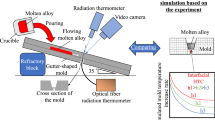Abstract
The design of improved casting systems requires accurate modeling of metal cooling processes. This can only be accomplished after determining the interfacial heat transfer coefficient (IHTC) between a solidifying casting and its mould. In the current work, a simple and robust inverse heat conduction technique was applied for the estimation of the effective IHTC between an aluminum alloy casting and a steel permanent mould during solidification. The solidification of the alloy at varying mould preheating temperatures was monitored using a thermocouple, and the experimental cooling curves were compared with curves simulated by casting solidification modeling software. The IHTC value applied to the software was varied until its output converged with the experimental data, leading to an estimation of 6000 W/m2K for this system. This technique is useful as a preliminary tool in materials modeling, and it will promote the development of improved casting processes without the need for excessive experimentation.





Similar content being viewed by others
References
Vandersluis E, Lombardi A, Ravindran C, Bois-Brochu A, Chiesa F and MacKay R, Mater Sci Eng A 648 (2015) 401.
Khan S, Ravindran C, Naylor D and Sharma D, AFS Trans 108 (2000) 445.
Gau Z -P, Xiong S -M, Murakami M, Matsumoto Y and Ikeda S, China Found 4 (2007) 5.
Liu Y, Guo J -J, Jia J, Li Y -X, Su Y -Q and Ding H -S, Trans Nonfer Metals Soc China 13 (2003) 1119.
Pariona M and Mossi A, J Brazil Soc Mech Sci Eng 27 (2005) 399.
Murakawa H, Beres M, Vega A, Rashed S, Davies C, Dye D and Nikbin M, Trans JWRI 75–80 (2008) 37.
Hasan H, Peet M, Jalil J and Bhadeshia K, Heat Mass Transf 47 (2010) 1.
Venkataramani R and Ravindran C, AFS Trans 104 (1996).
Woodbury K, Chen Y, Parker J and Piwonka T, AFS Trans 106 (1998) 705.
Ho K and Pehlke R, Metall Trans 16B (1985) 585.
Krishnan M and Sharma D, AFS Trans 102 (1994) 769.
Guo Z -P, Xiong S -M, Liu B, Li M and Allison J, Int J Cast Metals Res 22 (2009) 327.
Davis J R (Ed.), ASM Specialty Handbook: Aluminum and Aluminum Alloys (ASM International, 1993).
Davis J R (Ed.), ASM Specialty Handbook: Carbon and Alloy Steels (ASM International, 1996).
Samuel F, Ouellet P, Samuel A and Doty H, Metall Mater Trans A 29 (1998) 2871.
Djurdjevic M, Kierkus W, Byczynski G, Stockwell T and Sokolowski J, AFS Trans 107 (1999) 173.
Callister W, Materials Science and Engineering: An Introduction, 8th edn. (Wiley, 2010).
Paul C and Venugopal P, Int J Mech Eng Technol 1 (2010) 253.
Acknowledgements
The authors are grateful to the Natural Sciences and Engineering Research Council of Canada (NSERC) for their financial support and to Thomas Warren of Gamma Foundries Inc. for chemical analysis of samples. Furthermore, the authors are thankful to Alan Machin, Dr. Anthony Lombardi and the members of the Centre for Near-net-shape Processing of Materials (CNPM) at Ryerson University for assistance during mould design and alloy casting.
Author information
Authors and Affiliations
Corresponding author
Rights and permissions
About this article
Cite this article
Vandersluis, E., Ravindran, C. Estimating the Effective Metal-Mould Interfacial Heat Transfer Coefficient via Experimental-Simulated Cooling Curve Convergence. Trans Indian Inst Met 71, 1231–1236 (2018). https://doi.org/10.1007/s12666-017-1259-7
Received:
Accepted:
Published:
Issue Date:
DOI: https://doi.org/10.1007/s12666-017-1259-7




